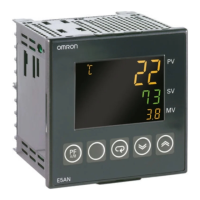60
Using ON/OFF Control Section 3-7
3-7 Using ON/OFF Control
In ON/OFF control, the control output turns OFF when the temperature being
controlled reaches the preset set point. When the manipulated variable turns
OFF, the temperature begins to fall and the control turns ON again. This oper-
ation is repeated over a certain temperature range. At this time, how much the
temperature must fall before control turns ON again is determined by the Hys-
teresis (Heating) parameter. Also, what direction the manipulated variable
must be adjusted in response to an increase or decrease in the process value
is determined by the Direct/Reverse Operation parameter.
3-7-1 ON/OFF Control
• Switching between 2-PID control and ON/OFF control is performed using
the PID ON/OFF parameter in the initial setting level. When this parame-
ter is set to pid, 2-PID control is selected, and when it is set to onof, ON/
OFF control is selected. The default is onof.
Hysteresis • With ON/OFF control, hysteresis is used to stabilize operation when
switching between ON and OFF. The control output (heating) and control
output (cooling) functions are set in the Hysteresis (Heating) and Hystere-
sis (Cooling) parameters, respectively.
• In standard control (heating or cooling control), the setting of the Hystere-
sis (Heating) parameter in the adjustment level is used as the hysteresis
regardless of whether the control type is heating control or cooling con-
trol.
Three-position
Control
• In heating/cooling control, a dead band (an area where both control out-
puts are 0) can be set to either the heating or cooling side. This makes it
possible to use 3-position control.
PV
ON
OFF
Reverse operation
Hysteresis (heating)
Set

